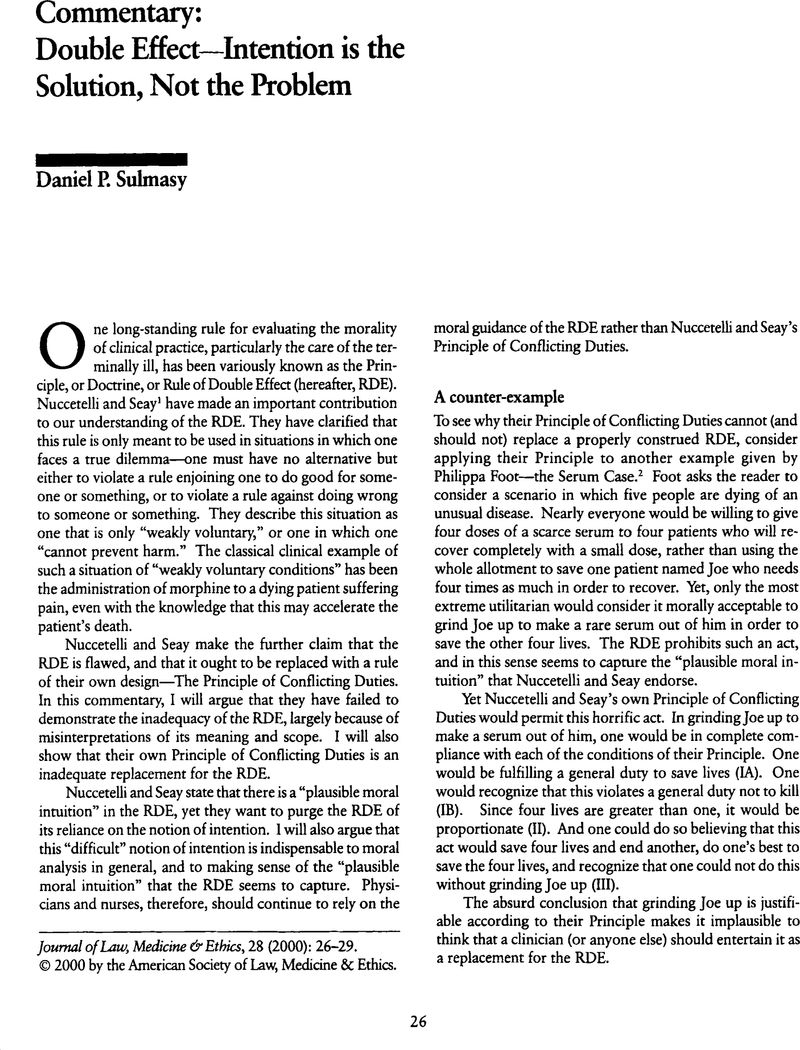Crossref Citations
This article has been cited by the following publications. This list is generated based on data provided by Crossref.
Cameron, Miriam E
2002.
Older Persons’ Ethical Problems Involving Their Health.
Nursing Ethics,
Vol. 9,
Issue. 5,
p.
537.
Clarfield, A. Mark
Gordon, Michael
Markwell, Hazel
and
Alibhai, Shabbir M. H.
2003.
Ethical Issues in End‐of‐Life Geriatric Care: The Approach of Three Monotheistic Religions—Judaism, Catholicism, and Islam.
Journal of the American Geriatrics Society,
Vol. 51,
Issue. 8,
p.
1149.
Pestaner, Joseph P.
2003.
End-of-Life Care: Forensic Medicine v. Palliative Medicine.
Journal of Law, Medicine & Ethics,
Vol. 31,
Issue. 3,
p.
365.
Bell, Susan Givens
2004.
The Pharmacology of Palliative Care.
Neonatal Network,
Vol. 23,
Issue. 6,
p.
61.
Levy, Michael H.
and
Cohen, Seth D.
2005.
Sedation for the relief of refractory symptoms in the imminently dying: A fine intentional line.
Seminars in Oncology,
Vol. 32,
Issue. 2,
p.
237.
McClung, John Arthur
2007.
End-of-Life Care in the Treatment of Heart Failure in the Elderly.
Clinics in Geriatric Medicine,
Vol. 23,
Issue. 1,
p.
235.
McClung, John Arthur
2007.
End-of-Life Care in the Treatment of Heart Failure in the Elderly.
Heart Failure Clinics,
Vol. 3,
Issue. 4,
p.
539.
Arjoon, Surendra
2007.
Ethical Decision-Making: A Case for the Triple Font Theory.
Journal of Business Ethics,
Vol. 71,
Issue. 4,
p.
395.
Spielthenner, Georg
2008.
The principle of double effect as a guide for medical decision-making.
Medicine, Health Care and Philosophy,
Vol. 11,
Issue. 4,
p.
465.
Campbell, Margaret L.
2008.
Treating Distress at the End of Life.
AACN Advanced Critical Care,
Vol. 19,
Issue. 3,
p.
340.
Truog, Robert D.
Campbell, Margaret L.
Curtis, J Randall
Haas, Curtis E.
Luce, John M.
Rubenfeld, Gordon D.
Rushton, Cynda Hylton
and
Kaufman, David C.
2008.
Recommendations for end-of-life care in the intensive care unit: A consensus statement by the American College of Critical Care Medicine.
Critical Care Medicine,
Vol. 36,
Issue. 3,
p.
953.
MANCUSO, THOMAS
and
BURNS, JEFFREY
2009.
Ethical concerns in the management of pain in the neonate.
Pediatric Anesthesia,
Vol. 19,
Issue. 10,
p.
953.
Lentz, Scott E.
2011.
Gynecologic Oncology.
p.
509.
Billings, J Andrew
2011.
Double effect: a useful rule that alone cannot justify hastening death.
Journal of Medical Ethics,
Vol. 37,
Issue. 7,
p.
437.
Johnston, Wendy S.
Hoskins, Katelin
and
McCluskey, Leo
2011.
Amyotrophic Lateral Sclerosis.
Neurology,
Vol. 76,
Issue. 7_supplement_2,
Billings, J. Andrew
and
Churchill, Larry R.
2012.
Monolithic Moral Frameworks: How Are the Ethics of Palliative Sedation Discussed in the Clinical Literature?.
Journal of Palliative Medicine,
Vol. 15,
Issue. 6,
p.
709.
McClung, John Arthur
2017.
End-of-Life Care in the Treatment of Heart Failure in Older Adults.
Heart Failure Clinics,
Vol. 13,
Issue. 3,
p.
633.





